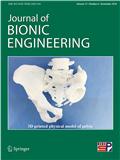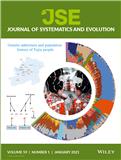仿生工程学报(英文版)(Journal of Bionic Engineering)杂志栏目及论文类型发文方向
/有基金 100.0%
仿生工程学报(英文版)(Journal of Bionic Engineering)杂志征稿要求
1、投稿方式:在线投稿。
2、官网网址:http://jbe.jlu.edu.cn/
https://link.springer.com/journal/42235
3、投稿系统:
https://www.editorialmanager.com/jben
4、出刊日期:双月刊,逢单月出版。
2023年8月24星期四
《仿生工程学报(英文)》投稿方式
【官网信息】
Submit manuscript:
https://www.editorialmanager.com/jben/default.aspx
For inquiring the status of manuscript, please send email to:
fsxb@jlu.edu.cn
《仿生工程学报(英文版)》投稿指南
【官网信息】
Author Guideline
AIMS AND SCOPE
The
Journal of Bionic Engineering publishes original research papers and
reviews on all aspects of bionic science and engineering including
fundamental understandings of animals and plants for bionic engineering,
such as locomotion and behaviors of animals, structures, composites,
morphology and physical properties of plants and natural materials,
applications of such understandings in engineering, technology and
designs.
The
journal aims to promote research and provide a platform for
communication of novel ideas, theories and technologies in bionic
science and engineering.
GUIDE FOR AUTHORS
Submission of manuscripts
Submission
of an article implies that the work described has not been published
previously and is not under consideration for publication elsewhere
(except in the form of an abstract or academic thesis or presentation in
conference).
Upon
acceptance of an article, authors will be asked to transfer copyright
to the publisher. This transfer will ensure the widest possible
dissemination of information.
Manuscripts
for consideration should be submitted online at:
‘http://jbe.jlu.edu.cn’ or ‘http://ees.elsevier.com/bionic/’ or by
e-mail: fsxb@jlu.edu.cn
Preparation of manuscripts
Microsoft Word (.doc or .docx) should be used.
1.
Manuscripts should be written in English. Authors whose native language
is not English are strongly advised to have their manuscripts checked
by an English-speaking colleague prior to submission.
2.
Manuscripts should be prepared in single column with wide margins and
double spacing throughout. Every page of the manuscript, including the
title page, references, tables, etc. should be numbered. All variables
and Greek letters should be in italic, and all constants should be in
Times New Roman. Vectors or matrix variables should be in bold italic.
3.
Manuscripts in general should be organized in the order: Title page,
Abstract, Keywords, Text, Acknowledgement, References, Figures, Tables,
List of figure captions.
Title
page: This page should contain a concise and descriptive title with no
more 80 characters, name(s) of author(s), affiliation(s), city, zip
code, country, E-mail of the corresponding author.
Abstract:
The abstract should be clear, informative and not longer than 200 words
to outline the objective, method and main results.
Keywords:
Authors are asked to provide 3 to 6 items for cross-indexing of this
paper. The keywords should be placed below the abstract with one space
line apart from it.
Text:
The text should contain an Introduction to put the paper in proper
perspective for the audience, Materials and Methods, Results and
Discussion, and Conclusion sections. Section and subsection headings
must be numbered in the decimal system, e.g. 1, 1.1,1.1.1 etc.;section
and subsection headings should not be run within the text; they should
be typed on a separate line, without indentation. Upper case is used
only for the first letter of the first word of the headings. Equations
should be numbered consecutively in Arabic numerals in parentheses on
the right-hand margin and cited in the text, e.g. Eq. (1).
Illustrations:
Each illustration must be prepared on a separate page; never embodying
the illustrations in the Text. Illustrations should be companied by
appropriate captions and numbered according to their sequence in the
text, e.g. Fig. 1,
Fig.
2a. The text should include references to all illustrations. A separate
page should be used to list the captions of the illustrations at the
end of the manuscript. The width of a single column illustration is 8 cm
and that of a double page illustration is 16 cm; therefore, if
possible, make illustrations close to these two sizes; otherwise,
attention should be paid that after reduction the illustrations should
be clearly readable. In illustrations, the data line should be thicker
than the axes.
Tables:
Each table must be prepared on a separate page; never embodying the
tables in the Text. Each table should have a brief and self-explanatory
title and be numbered according to its sequence in the text, e.g. Table
1, Table 2. The text should include references to all tables. The
headings of columns should include proper abbreviations of units in
parentheses, e.g. (g), (mm). Any explanation essential to the
understanding of the table should be given as a footnote at the bottom
of the table.
Acknowledgements:
Individuals or group other than the authors who were direct help in the
work should be acknowledged. Information on research grants should be
mentioned here.
References:
References should be typed on separate page. All references should be
numbered in Arabic numerals according to their sequence in the text and
bracketed, e.g. [1], [2,3] and [4–7] as superscripts. Personal
communications and unpublished data are not acceptable as references.
Different kinds of references should be referred to as follows.
•
Papers in periodicals should be referred in the order: name of
author(s), title of paper, name of periodical (in italic), year, Volume
(in bold), and pages. For example:
[1] Vincent J F V. Dynamics of drying in phenolically tanned materials. Journal of Bionic Engineering, 2004, 1, 4−8.
•
Books should be referred to in the order: name of author(s), title of
books (in italic), publishing house, city, country, year, and pages. For
example:
[2] Ren L Q. Optimum Design and Analysis of Experiments,
2nd ed, Higher Education Press, Beijing, China, 2003. (in Chinese)
•
Papers in conference proceedings should be referred to in the order:
name of author(s), title of paper, name of conference(initalic), city,
country, year, and pages. For example:
[3] Ren L Q, Tong J, Li J Q, Chen B C. Soil adhesion and biomimetics of soil-engaging components in anti-
adhesion against soil: A review. Proceedings of the 13th International Conference of ISTVS, Munich, Germany, 1999, 233−240.
•
Website online publication should be referred in the order: name of
author(s) (if available), title of paper or web page, [date], and
website address. For example:
[4] Stockman A, Sharpe L T. Color & Vision Database, [2005-04-05], http://cvision.ucsd.edu
2017-03-16









